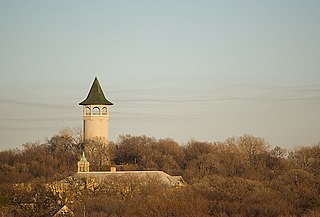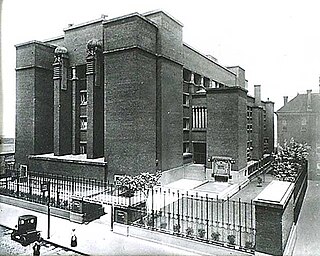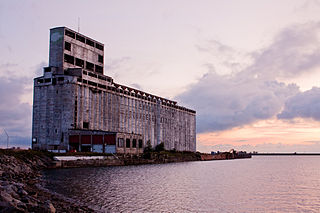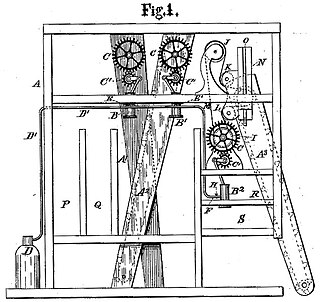
A grain elevator is a facility designed to stockpile or store grain. In the grain trade, the term "grain elevator" also describes a tower containing a bucket elevator or a pneumatic conveyor, which scoops up grain from a lower level and deposits it in a silo or other storage facility.

Prospect Park is a historic neighborhood within the University community of the U.S. city of Minneapolis, Minnesota. The area is bounded by the Mississippi River to the south, the City of Saint Paul, Minnesota to the east, the Burlington Northern railroad yard to the north, and the Stadium Village commercial district of the University of Minnesota to the west. The neighborhood is composed of several districts which include the East River Road area. The 1913 Prospect Park Water Tower is a landmark and neighborhood icon.

Carew Tower is a 49-story, 574-foot (175 m) Art Deco building completed in 1931 in the heart of downtown Cincinnati, Ohio, United States, overlooking the Ohio River waterfront. The structure is the second-tallest building in the city, and it was added to the register of National Historic Landmarks on April 19, 1994. The tower is named after Joseph T. Carew, proprietor of the Mabley & Carew department store chain, which had previously operated in a building on the site.

The Larkin Building was an office building in Buffalo, New York, noted for innovations that included central air conditioning, built-in desk furniture, and suspended toilet partitions and bowls. Located at 680 Seneca Street, it was demolished in 1950.

The Ellicott Square Building is a historic office complex, completed in 1896, located in Buffalo, New York. It is found within the Joseph Ellicott Historic District.

The Rookery Building is a historic office building located at 209 South LaSalle Street in the Chicago Loop. Completed by architects Daniel Burnham and John Wellborn Root of Burnham and Root in 1888, it is considered one of their masterpiece buildings, and was once the location of their offices. The building is 181 feet (55 m) in height, twelve stories tall, and is considered the oldest standing high-rise in Chicago. It has a unique construction style featuring exterior load-bearing walls and an interior steel frame, providing a transition between accepted and new building techniques. The lobby was remodeled in 1905 by Frank Lloyd Wright. From 1989 to 1992, the lobby was restored to Wright's design.

Buffalo–Exchange Street station is an Amtrak station in Buffalo, New York. The station serves six Amtrak trains daily: two daily Empire Service round trips between Niagara Falls and New York City and one Maple Leaf round trip between Toronto and New York City. There is also daily Amtrak Thruway bus service at the station, operating between the Buffalo Metropolitan Transportation Center and Jamestown station in Jamestown, New York, via Dunkirk and Fredonia, and serving the communities along the southeast shore of Lake Erie.

Northwestern Consolidated Milling Company Elevator A also known as the Ceresota Elevator and "The Million Bushel Elevator" was a receiving and public grain elevator built by the Northwestern Consolidated Milling Company in 1908 in Minneapolis, Minnesota in the United States. The elevator may have been the largest brick elevator ever constructed and ran on electricity. The elevator was the source for the Crown Roller Mill and Standard Mill. Those mills closed in the 1950s but the elevator continued in use for grain storage until the mid 1980s. The building is a contributing property of the St. Anthony Falls Historic District listed in the National Register of Historic Places in 1971. For this article north is toward the river.

Northern Lines Railway is a shortline railroad operating 17 miles (27 km) of track in and near St. Cloud in central Minnesota. The railroad was formed in 2004 to operate Burlington Northern Santa Fe trackage in and near the St. Cloud area and started operations in 2005. Interchange is made with BNSF in east St. Cloud or at the rail yard in central St. Cloud.

Silo Point, formerly known as the Baltimore and Ohio Locust Point Grain Terminal Elevator, is a residential complex converted from a high-rise grain elevator on the edge of the Locust Point neighborhood in Baltimore, Maryland. When the original grain elevator was opened in September 1924, it was the largest and fastest in the world. The condominium now rises to 300 feet. The original 206 foot tall grain elevator was built by the Baltimore and Ohio Railroad in 1923–1924, with a capacity of 3.8 million bushels. Between 2004 and 2009 the structure was converted from a grain elevator to a condominium tower containing 24 floors and 228 condominiums by Turner Development Group and architect Parameter, Inc.

Concrete-Central Elevator is a historic grain elevator located on the Buffalo River at 175 Buffalo River Buffalo in Erie County, New York.

Mill City Museum is located in the ruins of the Washburn "A" Mill next to Mill Ruins Park on the banks of the Mississippi River in Minneapolis. The museum, an entity of the Minnesota Historical Society that opened in 2003, focuses on the founding and growth of Minneapolis, especially flour milling and the other industries that used hydropower from Saint Anthony Falls. The mill complex that the museum is within, dates from the 1870s and is listed on the National Register of Historic Places. It is also part of the St. Anthony Falls Historic District and within the Mississippi National River and Recreation Area.

The Cargill Pool Elevator is a grain storage facility in Buffalo harbor built in the 1920s and previously named the Saskatchewan Cooperative Elevator. The elevator is the only grain elevator in Buffalo that is located directly adjacent to Lake Erie.

Robert Dunbar was a Scottish mechanical engineer. He designed the first steam-powered grain elevator in the world and the majority of the first grain elevators in Buffalo, New York City, and Canada.

The Erie Basin Marina is a municipal inland harbor in Buffalo, New York. The marina is primarily for residential usage, containing a large array of boat docks, gardens, and a public observatory overlooking the city and waterfront. The marina's harbor discharges into the Niagara River and Lake Erie.

The Bowling Green Offices Building is an office building located at 11 Broadway, across from Bowling Green park in the Financial District of Manhattan in New York City. The 21-story building, erected between 1895 and 1898, is 272.5 feet (83.1 m) tall.

The Railroad and Bank Building at 176 E. 5th Street in St. Paul, Minnesota, renamed Great Northern Building in 2019, was the largest office building in the Upper Midwest from its completion in 1914 until 1973. For most of its existence, it was the headquarters of the business empire created by 19th century railroad entrepreneur James J. Hill. The building is the work of architect Charles Sumner Frost and is a contributing property of the St. Paul's Lowertown Historic District. After the decline of the railroads in the United States, the building has been used as leased office space with some retail operations on the lower floors.

The Historic Ely Elevator, also known as the Woitishek-King-Krob Elevator and Feed Mill, is an "iron-clad" wood-cribbed grain elevator, located in Ely, Iowa. The Historic Ely Elevator was built in 1900 along the Burlington, Cedar Rapids and Northern Railway. It is a contributing property of the Dows Street Historic District, which is listed on the National Register of Historic Places.





























